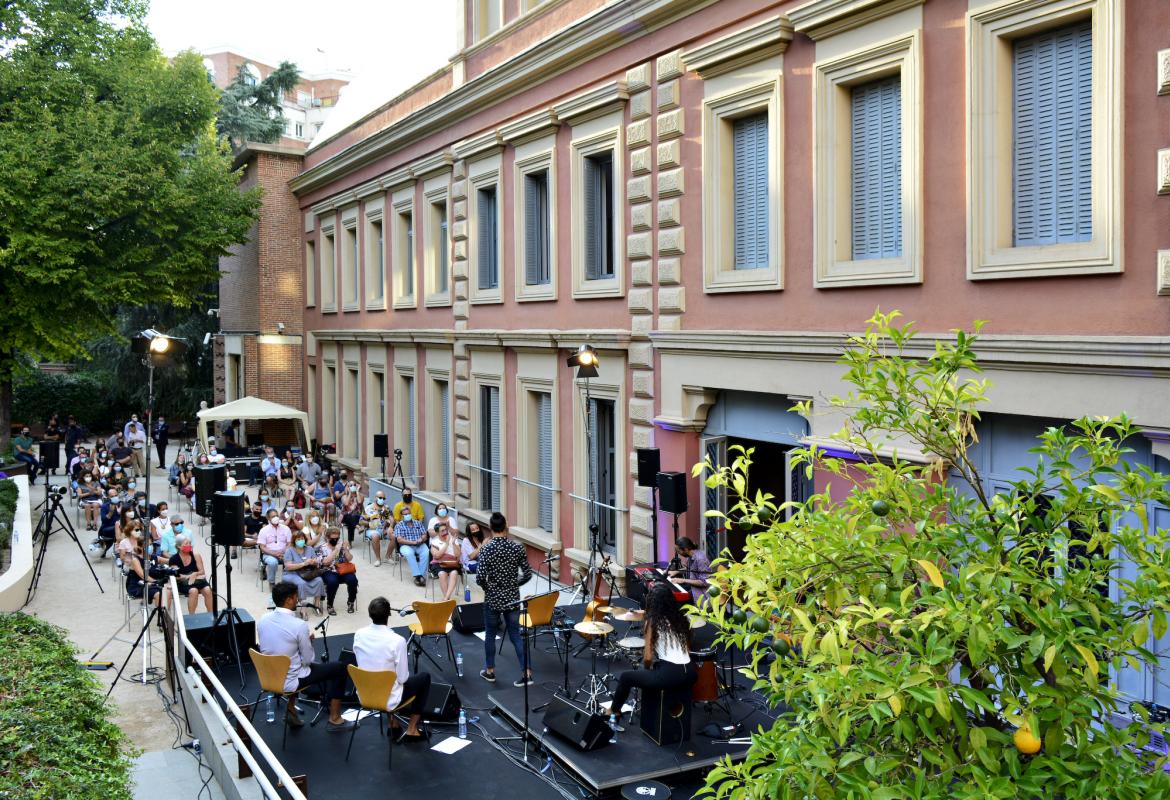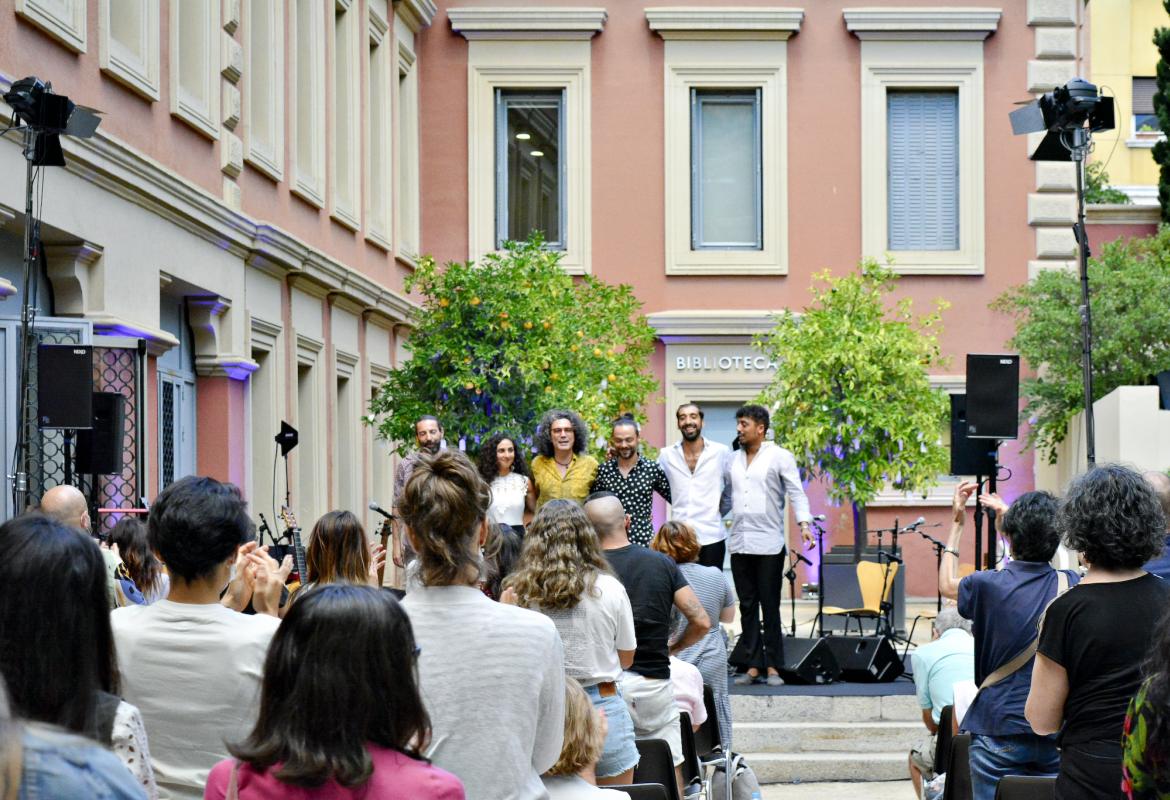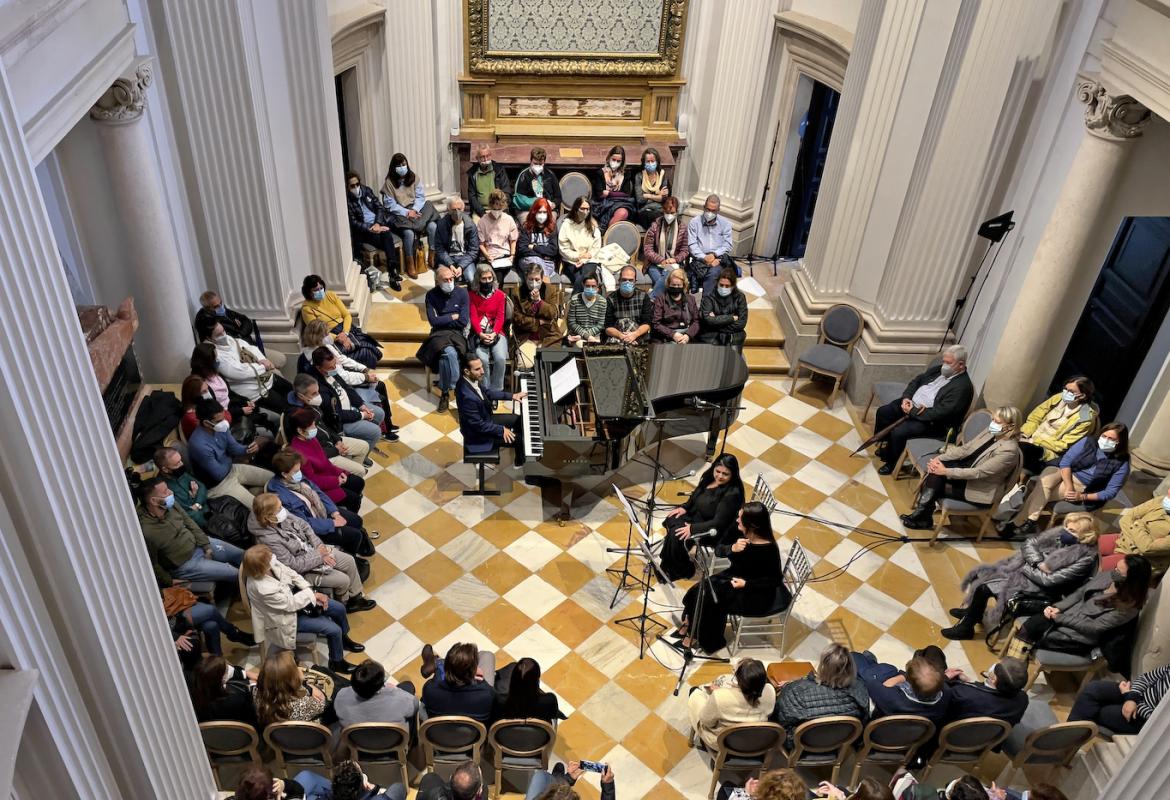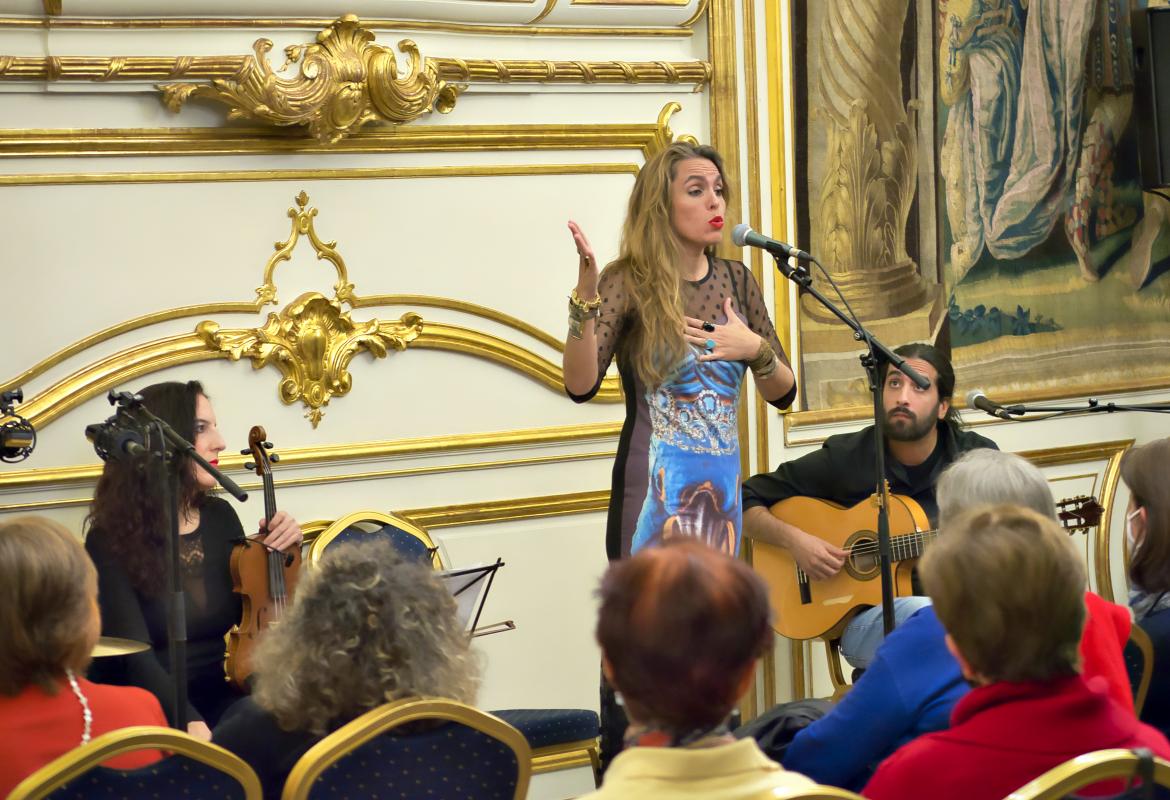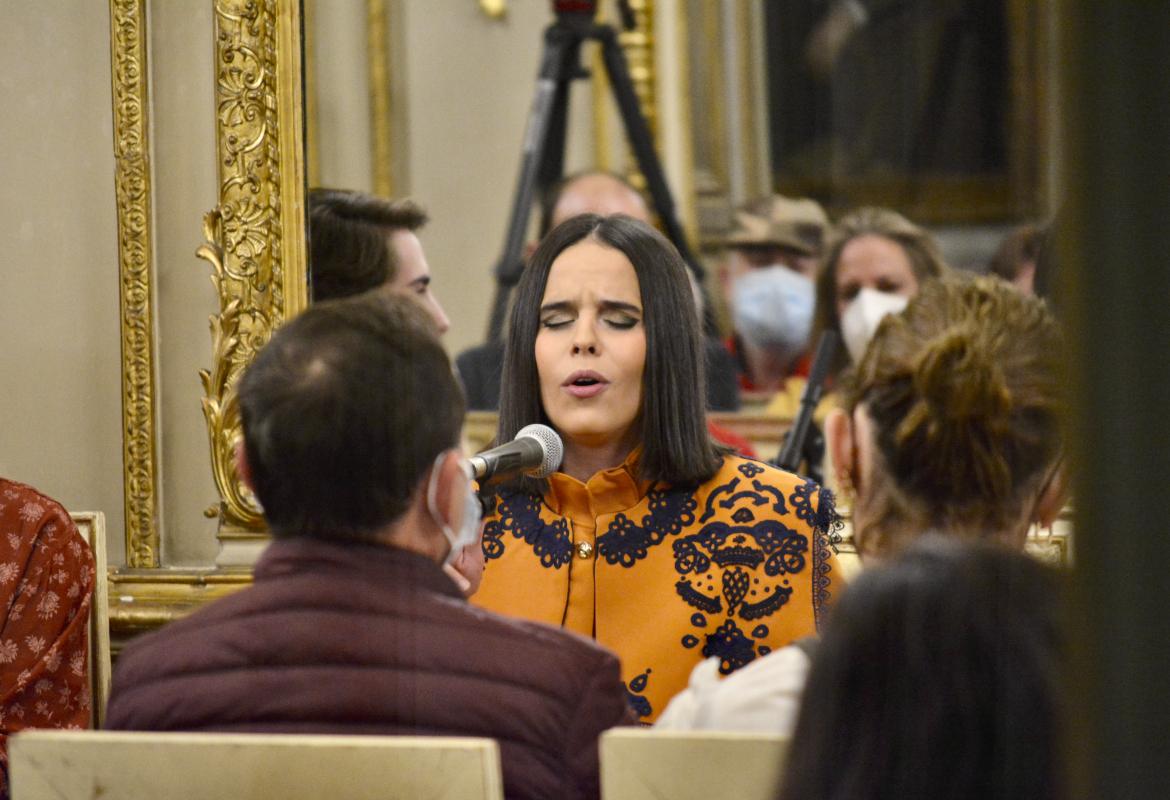
This is how it was...Flamenco in the palace. A diverse look at flamenco heritage
Enjoy the Welcome to the Palace! 2021 concerts again.
Declared in 2010 by UNESCO as Intangible Cultural Heritage of Humanity, flamenco has transcended its Andalusian origins to become a universally recognized hallmark of cultural identity. Approximately half a century before this recognition, in the 1950s, the Madrid region began to become a hive of this art, generated by the boom in tourism and the migration of artists attracted by the opportunities offered by the capital. Since then, Madrid has been considered the nerve center of flamenco art, where historic tablaos have prospered to this day.
The arrival of the covid-19 pandemic has devastated the fabric of Madrid tablaos. The temples of flamenco singing, dancing and playing are generally small interior spaces full of spectators –who can witness the energy of the ritual just a few centimeters from each other–. Today, this peculiarity is incompatible with the current sanitary restrictions, which has led to a massive closure of most establishments, including centenary tablaos.
aware of all this, the General Directorate of Cultural Heritage presented the cycle Flamenco in the palace. A diverse look at jondo heritage as part of Welcome to Palacio 2021, in order to vindicate flamenco as indisputable heritage and cultural legacy. In this way, it also contributed to the support of the artists' collective in this crisis caused by the closure of their usual work centers.
Flamenco in the palace. A diverse look at jondo heritage It was a cycle of Cultural Heritage of the Community of Madrid that exhibited a varied sample of the flamenco musical heritage, at the same time that it offered a unique opportunity to visit some of its extraordinary palaces, converted into stages for the occasion. Committed to the current complex moment that the sector is going through, this cycle also supported and highlights the extraordinary talent of artists with an international career who reside mainly in the Community of Madrid, as an example of sustainability and cultural coherence.
Cycle organized by the General Directorate of Cultural Heritage of the Community of Madrid with the musical curator of The Other.

Perhaps thanks to its natural versatility, flamenco has shown an enormous capacity for amalgamation with other identities and sound heritages. The essence of flamenco art is identified with cultural miscegenation from its very roots, in which gypsy, Arab, Byzantine and Sephardic traditions merge. To all of them is added the American folklore, crystallized in the "songs of round trip" or flamenco styles that, after soaking up different Latin music, were re-imported by the Spanish migrants who returned to the peninsula after passing through the Americas.
Since the 80s, the expression flamenco fusion –synonymous with others such as new flamingo o flemish fusion– has validated the richness of the musical miscegenation between flamenco art and styles such as jazz, blues, rock, pop or world music, among others.
Recognized as one of the world references for the meeting of flamenco with other sound cultures, Guerrero presented a concert with the most celebrated of his eclecticism rooted in flamenco: from a tribute to the golden age of copla between the decades of the 50s and 70s to the celebrated “round trip” of flamenco to the Americas –in which he fuses sounds originally as disparate as the slow-tempo bulería, characteristic of the geographical triangle between Lebrija, Utrera and Morón, and the ballad popularized at the same time by trumpet players Louis Armstrong, Chet Baker and Miles Davis–, without forgetting the heritage and sound heritage of the Spanish-speaking world with dances such as the Argentine tango and the chachachá, the Columbian rumba and the Cuban guaguancó.
Palace Gardens Parque Florido
Lázaro Galdiano Museum
September 9 2021
Diego Guerrero
The singer, guitarist, arranger and music producer Diego Guerrero is an international reference in flamenco fusion. A native of Huelva, Guerrero was trained in the conservatories of Seville, Granada and Córdoba, where during the day he studied composition and orchestral music, and at night he immersed himself in the flamenco neighborhoods with a guitar next to a candle.
Arte jondo aside, jazz, soul, Latin and Afro-American music come together in this musical agitator, a master provocateur of exchanges. This was demonstrated in the feat of connecting the best talents from each genre in the legendary Café Berlín in Madrid: for three years, Guerrero organized a jam session weekly in which he shared the stage with names like Jorge Pardo, Pepe Habichuela, Josemi Carmona, Javier Colina or Alain Pérez, among many others, generating unforgettable sessions that constituted an unmissable weekly event for fans from the five continents.
His vital encounter with the pioneer of Latin jazz Jerry González – they shared a house for five years – led to the birth of a new vision of the bridges that had been built up to that point between flamenco, Latin jazz and Afro-Cuban music. your disk I come walking (2017), an eclectic work based on flamenco that opens the doors to other styles, was nominated for a Latin Grammy in the category of Best Flamenco Music Album. Diego Guerrero has performed at festivals such as Etnosur, Jazz y Más, Festival Grec in Barcelona, La Suma Flamenca, Womad, La Noche Blanca de Flamenco in Córdoba, Gent Festival or the San Sebastián Jazz Festival, as well as in the main theaters and auditoriums in Australia, New Zealand, South Korea, Croatia, Belgium, Italy and Germany.
Diego Guerrero Septet:
Diego Guerrero, voice and flamenco guitar
Benito Bernal, flamenco guitar
Juan Motos, choirs and clapping
Cheto Muñoz, choirs and clapping
Nasrine Rahmani, percussion
Ivan Ruiz Machado, bass
JM Pedraza "Petaca", piano or keyboard
More information in diegoguerrero.es

Although the guitar has traditionally been the instrument that provides melodic, harmonic and rhythmic accompaniment to flamenco art, the piano is already beginning to reclaim its place in contemporary flamenco. His ability to create unprecedented atmospheres and textures in flamenco sonorities opens up a whole universe of innovative possibilities in the accompaniment of cante.
From this starting point, Pablo Rubén Maldonado, one of the most outstanding pianists on the scene, presented a flamenco anthology together with two female voices, charismatic and with complementary timbres such as Chelo Pantoja and María Mezcle. In this concert they presented a journey through the most traditional palos –soleá, seguiriyas, bulerías, alegrías, fandangos, tangos, cantes de Levante, etc.– which they reinterpreted with a double contemporary nuance.
On the one hand, Maldonado is based on the pre-existing melodies of these cantes to introduce his own lyrics with a renovating intention, since today conventional flamenco continues to reproduce texts anchored in the past. By creating his own message, Maldonado is actually breaking tradition in order to perpetuate tradition, reviving the ancient practice of singing both social and individual problems, of the present and of the day to day.
Lastly, this anthology offered a contemporary sound from the modernity of the piano as an instrument, whose concept is not based on the imitation of the guitar, but rather on the creation of its own language with the almost infinite possibilities of the keyboard.
Palace Infante Don Luis de Borbón
Boadilla del Monte
on October 30, 2021
Pablo Rubén Maldonado + María Mezcle + Cello Pantoja
Self-taught in the language of flamenco piano art, the Granada Paul Ruben Maldonado He is one of the leading pianists on the flamenco scene. He is a descendant of a gypsy family with a deep musical tradition – in which we can find Antonio cujon, creator of the Granada zambra–. Among others, he has received the national Flamenco Hoy award for his recording work Out of reality, and has shared the stage at festivals around the world with figures such as Carmen Linares, Estrella Morente, Farruquito, Marina Heredia and many more.
The singer, composer and producer Maria Mix grew up in a family environment of flamenco artists such as Juan Ortega Gómez the mix and Maria Vargas. A great connoisseur of cante and its styles, she has received awards such as the National Award for Alegrías at the Las Minas National Cante Contest, First Prize for Saetas in Jerez, Seville and Córdoba, or the Gold Badge of Sanlúcar de Barrameda, her homeland. . Her discography includes Maria Mix (2010) and Nude (2016)
Born in Jerez and belonging to an outstanding family of flamenco artists, Cello Pantoja is currently one of the reference voices of cante. At the age of fourteen she embarked on a tour with Camarón, Paco de Lucía, Tomatito and Dorantes; At twenty she moved to Madrid to work with Lola Flores. She has shared the stage with artists such as Joaquín Grilo, Adrian Galia, Antonio Canales, Sara Baras or Joaquín Cortés, in whose company she would be the only female voice. She ambassadors of flamenco art around the world, in 2013 she was chosen the voice of Flamenco in Caxia do Sul (Brazil).
Paul Ruben Maldonadopiano
Maria Mix, sing
Cello Pantoja, sing
More information:
Pablo Ruben Maldonado website
Maria Mezcle's Facebook
Chelo Pantoja's Instagram

What presence does gender equality have in flamenco? On the International Day Against Gender Violence (November 25), the singer, sociologist and activist Lourdes Pastor put her flamenco voice at the service of women's rights, from what she calls "social flamenco".
The title of this concert, which comes from a popular copla ("If women had the freedom of men / they would go out on the roads to steal hearts"), wanted to be a metaphor for the situation of subjugation of women in flamenco – an art traditionally dominated by men – whose lyrics even reflect the normalization of mistreatment.
From a fusion of styles –where musical miscegenation is a metaphor for the values of the crossroads of cultures–, Pastor displays a sharp critical spirit, with lyrics that defend gender equality and the most disadvantaged, miscegenation, freedom and democracy, something not very common in the flamenco world. An example is your feminist pile driver, the first of its kind in a style traditionally associated with men, since it is considered a forge song linked to iron work.
Convinced of the transforming power of music in society, Pastor offered in this concert her own songs on social aspects of furious current affairs, such as gender violence - her theme reflections in the dark is dedicated to minors, also victims – or the migratory tragedy that is experienced in our borders.
Palacio de Viana
Ministry of Foreign Affairs, European Union and Cooperation
on November 25, 2021
Lourdes pastor
Of Cordovan and mestizo origin, the singer, sociologist and activist Lourdes Pastor –she studied Sociology due to her interest in understanding the marginalization of the gypsy people– belongs to a new generation of women who are reinterpreting the flamenco tradition through their own codes.
She grew up musically supported by a maternal family in which flamenco was present for several generations: her great-aunt, Visitación Martínez -known as the "the star of Cordoba"– stepped on stage charts around the world. Daughter of the feminist activist Rafaela Pastor, she has been involved in social and feminist activism since she was a teenager.
In 2017, she promoted the "Agenda for Women in Flamenco Intangible Cultural Heritage of Humanity" edition, for which she had the collaboration of Niña Pastori, Estrella Morente, Remedios Amaya and Mayte Martín. In 2018 she received recognition from the Delegation of the Junta de Andalucía in Brussels for her commitment to defending women's rights and her work promoting feminism in flamenco. In April 2021 she participated in the tribute that the Cervantes Institute paid to José Agustín Goytisolo, performing the song Words for Julia based on the writer's poem, whose verses have been covered by singers such as Rosa León, Mercedes Sosa, Paco Ibáñez and many others, as a hymn of resistance for generations that have survived dictatorships.
His published discography comprises Half the truth (2010) and Who will I sing to? (2014), which include songs of social criticism and feminist vindication through flamenco rhythms tinged with jazz, bossa nova and Cuban son. Her next work, The revolution around the corner (2022) is, in his own words, “a call to memory”. In addition to his own songs, Pastor rescues songs from the Transition and other protest songs turned into bulerías, tangos, martinetes, rumba or seguidillas.
Lourdes pastor, sing
Jesús Gómez, guitar
Manuel Reyes de la Rubia, Arango, percussion
Eles Bellido, fiddle
More information in lourdespastor.com

A singer who studies primary sources and the roots of flamenco art, Ángeles Toledano embodies the example of a new flamenco generation that, although always from a young perspective, reveals great concern for rescuing flamenco styles, styles and lyrics that are currently almost in disuse. His work to recover this patrimonial legacy brings to a new light examples such as the alegrías of Pastora Pavón, the tientos of Antonia Gilabert The Pearl of Cadiz, Antonio's bulerías the jacket, cantes por tarantas by singers as personal as Juan Coronel or a flamenco lullaby by Bernardo Álvarez The one with the wolves.
A native of Jaén, Toledano is also an ambassador of the cantes that champion her land, such as tarantas, Gabriel Moreno's tangos or Diego Moreno's malagueña The little person The cast of artists that accompany her tune in, from the toque and the clapping, to her classical line and her search for the roots of flamenco's past.
Fernán Núñez Palace
Foundation of the Spanish Railways
15 December 2021
Angeles Toledano
Born in Villanueva de la Reina (Jaén), Ángeles Toledano began at the age of seven to learn her first cantes from her grandfather and attend classes at the flamenco club in her town. An award-winning artist despite her youth, at only fourteen she won first prize in the Young Flamenco Contest organized by the Andalusian Federation of Flamenco Clubs, which made her the best singer under 25 in the province of Jaén . That same year he also won the First Young Prize in the Campanillas Flamenco Singing Contest (Málaga), as well as the first prizes in the adult category of the Guillena National Singing Contest (Seville) and the Ubrique National Contest ( Cadiz).
At the age of fifteen, he won the first prize and the Prize for the Best Fandangos at the Écija National Contest (Seville), as well as the “Manuel Mairena” Young Prize at the Cante Jondo Antonio Mairena contest, in Mairena del Alcor (Seville). She was also awarded the Prize for Songs Proceeding from Fandango at the XXXII International Festival of Flamenco Cante of Lo Ferro (Murcia), and has received the Art Prize awarded by the Andalusian Youth Institute.
At the age of 18, she received a scholarship to enter the prestigious flamenco school in Seville run by the Cristina Heeren Foundation, where she continued her training alongside teachers such as José de la Tomasa and Julián Estrada, among others. She has toured the US, performing in San Francisco, Houston, San Diego and Tijuana (Mexico), as well as stepping on stages in Paris, Munich, Milan and different cities in the Netherlands. In 2018 she won the Alcobendas Flamenca Contest for New Talents.
Angeles Toledano, sing
Benito Bernal, guitar
Alvaro Gamero, palms
Fernando Gamero, palms
More information in your Facebook




